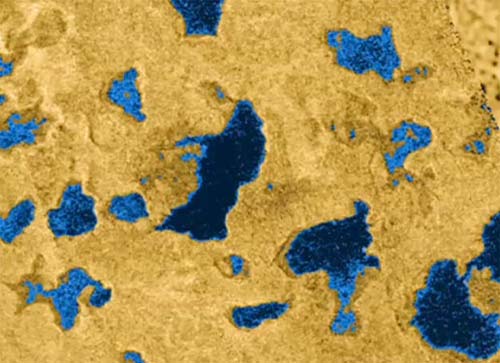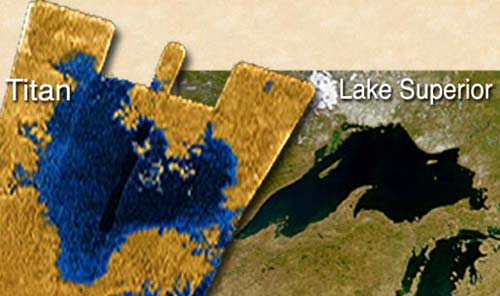Discover many large seas on Saturn's Titan satellite
Scientists of NASA's US aviation agency yesterday (March 13) announced that unmanned probe Cassini has found evidence of large seas on Saturn's largest satellite Titan satellite. One of these seas is larger than the size of the largest lake in the Great Lakes.
Through the analysis of photographs sent from Cassini, scientists say that the sea on Titan satellites contains methane or ethane gas, and this finding further strengthened previous explanations.
Jonathan Lunine, a University of Arizona research scientist and a direct analyst for Cassini data, said: 'We have been hypothesizing the sea on Titan satellites for a long time but now. With modern equipment, we have the first evidence of the great seas that we thought were small lakes before. '
NASA scientists say that Cassini's radar devices have captured several black spots near the north pole of Titan satellites. The largest point is 100,000 square kilometers (39,000 square miles).
Titan is the second largest satellite in our solar system behind Jupiter's Ganymede satellite and it is almost twice as big as our moon.

The image was taken by Cassini ship's radar devices on Tuesday March 13, 2007, scientists believe that the shape and black spots (in the blue zone) show the calmness of the seas.(Photo: NaSa)

(Photo: NaSa)
NASA said that although there is no evidence that these seas contain liquid but the shape and black spots on the radar indicate the stillness of these seas. The liquid can be methane or ethane gas because these compounds are abundant in Titan's atmospheric clouds.
Scientists say that the presence of the sea reinforces the hypothesis that Titan's surface has supplied methane to its atmosphere. Because of these photos, the Cassini mission team is adjusting its radar devices so that it can fly through the dark areas captured by its cameras.
The unmanned probe Cassini was launched into space in October 1997 and it went into Saturn's orbit in July 2004. Cassini was a joint product between NASA, the European airline and the body. Italian aviation authority.

Cassini-Huygens model with human-like characteristics. (NASA photo)
Impressive photos of Saturn
The Kiet
- Summer clouds on Saturn's Titan satellite
- Announcing the first geological map on Saturn's Titan satellite
- The hidden surface of Titan satellite's life
- March 25, 1655: Discovering Saturn's largest satellite is Titan
- Discover the Titan's large mountain range of Saturn
- Detecting signs of life on Saturn satellite
- There is liquid on Saturn's Titan satellite
- Detecting cell membrane material on Titan moon
- Earth and Titan are surprisingly similar
- New computer model about Moon Titan
- Ocean discovered on two Saturn satellites
- Saturn's moon wave is only 1 centimeter tall
 Van Allen's belt and evidence that the Apollo 11 mission to the Moon was myth
Van Allen's belt and evidence that the Apollo 11 mission to the Moon was myth The levels of civilization in the universe (Kardashev scale)
The levels of civilization in the universe (Kardashev scale) Today Mars, the sun and the Earth are aligned
Today Mars, the sun and the Earth are aligned The Amazon owner announced a secret plan to build a space base for thousands of people
The Amazon owner announced a secret plan to build a space base for thousands of people 1.4 billion km away, NASA's billion-dollar ship sent back a mysterious photo that surprised the scientific world
1.4 billion km away, NASA's billion-dollar ship sent back a mysterious photo that surprised the scientific world  Add a Saturn moon that owns the ocean and ... oxygen
Add a Saturn moon that owns the ocean and ... oxygen  Cassini spacecraft said the latest information
Cassini spacecraft said the latest information  Unknown things about Cassini
Unknown things about Cassini  NASA's $ 3.3 billion spacecraft is about to commit suicide on Saturn
NASA's $ 3.3 billion spacecraft is about to commit suicide on Saturn  Historical moments in Cassini's mission
Historical moments in Cassini's mission 